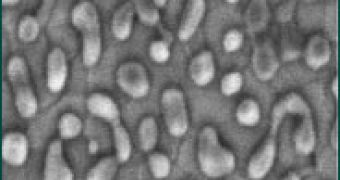"Imagine having computer memory so dense that a cubic centimeter contains 12.8 million gigabytes of information. Imagine an iPod playing music for 100 millennia without repeating a single song or a USB thumb-drive with room for 32.6 million full-length DVD movies. Now imagine if this could be achieved by combining a computing principle that was popular in the 1960s, a glass of water and wire three-billionths of a meter wide. Science fiction? Not exactly."
That's how the Drexel University press release begins. It doesn't sound very objective but they have good reasons for excitement. Jonathan Spanier and his research colleagues have found an unusual way for stabilizing ferroelectricity on the nano-scale.
Ferroelectric materials are materials that spontaneously display electric dipoles inside them. An electric dipole is a pair of electric charges, one positive, one negative, situated at a certain distance from one another. This pair of charges can be considered like a sort of compact electrical entity - called the electric dipole. The dipole has a certain orientation, which is conventionally taken from the negative charge toward the positive charge.
The problem with ferroelectric materials is that the dipoles are constantly and randomly shaking from one direction to another. It would be great if they weren't, because they would provide ideal miniscule storing devices - for instance the 'up' direction could represent 1 and the 'down' orientation 0.
The stabilization of this shaking is especially difficult at very small scales. At larger scales the shaking of a few dipoles doesn't count too much because one memory element is made of many dipoles and the 1 or the 0 is the result of the average of many dipoles. But fewer dipoles one has in one memory element more strict stabilization one has to employ. (One doesn't want the data on a hard disk to change spontaneously from time to time!)
Until recently, it was technologically difficult to stabilize ferroelectricity on the nano-scale (at scales a million times smaller than a millimeter). However, Spanier and his colleagues, Alexie Kolpak and Andrew Rappe of the University of Pennsylvania and Hongkun Park of Harvard University, have now proposed a new mechanism for stabilizing the ferroelectricity in nano-scaled materials: surrounding the charged material with fragments of water.
The scientists found that molecules such as hydroxyl (OH) ions, which make up water, and organic molecules, such as carboxyl (COOH), work better than metal electrodes (which are now utilized) at stabilizing ferroelectricity in nano-scaled materials.
"It is astonishing to see that molecules enable a wire having a diameter equivalent to fewer than ten atoms to act as a stable and switchable dipole memory element," said Spanier, an assistant professor of materials science and engineering at Drexel.
Spanier and his colleagues are excited about their findings, but say significant challenges still lie ahead, including the need to develop ways to assemble the nanowires as densely as possible, and to develop a scheme to efficiently write and read information from the nanowires. But eventually this can lead to incredibly small hard-drives having enormous storing capacity.

 14 DAY TRIAL //
14 DAY TRIAL //